Homemade Pickled Okra
Learn how to make Homemade Pickled Okra. From preparing the brine to packing and sealing the jars, this step-by-step guide will have you canning our favorite southern veggie with no added preservatives
Enjoy a little taste of summer all year by canning your own Homemade Pickled Okra! You’ll love these tender young pods of okra preserved in a brine with garlic, dill, and peppercorns.
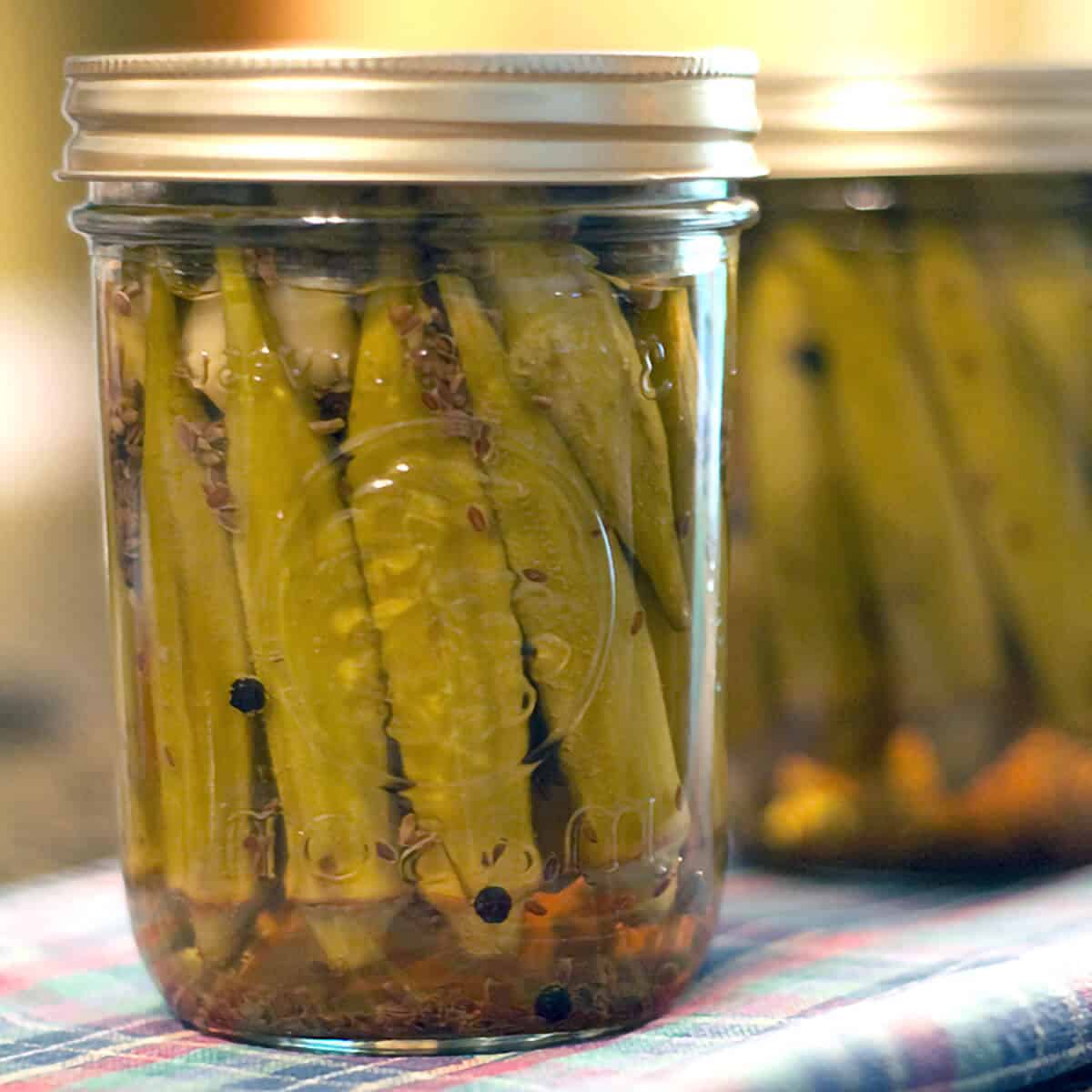
Summer is always a busy time for canning and preserving. I almost always make some Strawberry Jam and our favorite Kosher Dills along with a good Basic Salsa recipe and a few Quick Pickled Jalapenos. We’re already enjoying some of those this year.
I also like to make a few jars of Sugar-Free Bread and Butter Pickles to savor all through the fall and winter.
❤️ My Favorite Canning Recipe
No matter how busy I may be with other projects, I always make time during the summer to make a few jars of my favorite Pickled Okra.
Okra pickles have always been my personal favorite. I’ll breeze right by a dill pickle if these are around. I love a spear or two with a sandwich or just as an accompaniment to some good, old-fashioned southern vegetables. It’s also a great addition to an antipasto platter.
👩🏻🍳 Select the Okra Carefully
When I’m ready to make pickled okra, I hand select every pod for the recipe. Really. I literally stand there in the produce aisle or the farmer’s market and choose every single pod because I want them to be young, tender, and no longer than the depth of a pint jar – about 4 inches. It usually takes between 1 1/2 to 2 pounds to make three pints.
You’ll have to use your cook’s judgment based on the okra that is available to you. If you have leftovers, so much the better! Slice it, dredge it in some cornmeal and make Fried Okra or make Okra Chips!
❗ Prepare the Equipment
Start by preparing the jars, rings, and lids according to standard canning procedure. If you haven’t canned before, or if it’s been a while since your last canning session, please review the process and get all your equipment ready before you start.
👓 Review Procedures
One of the best resources for new and seasoned canners alike is the Ball Book of Canning and Preserving. It’s published by the people who make Ball canning jars. It’s available in lots of locations and on the web at amazon.com.
Some other good online resources are:
- National Center for Home Food Preservation (University of Georgia)
- Home Food Preservation Site (Pennsylvania State University)
- A Beginner’s Guide to Canning from Serious Eats
The National Center for Home Food Preservation even offers a free online course in food preservation. It’s well worth the time for the amount of information you get!
🛒 Ingredient and Equipment Notes
This post contains affiliate links. Lana’s Cooking is reader-supported and earns a tiny commission at no extra cost to you when you shop from our links.
- Fresh Okra (Choose pods that are free of blemishes and about 3-4 inches long. You’ll need approximately 2 pounds for the recipe.
- Garlic Cloves (Whole, peeled cloves.)
- Canning Salt (Canning salt is very pure with no added minerals or preservatives to prevent caking. Other salts will cause the pickling liquid to become cloudy.)
- Dried Dill Seed (Find this with the spices in your grocery store.)
- Whole Peppercorns (I use common black peppercorns. White, pink, or green also work.)
- White Vinegar (5% acidity) (To make a pickled product safe for pantry storage, vinegar with at least 5% acidity is required. Regular white vinegar meets that requirement.)
- Pint Canning Jars, Lids, and Rings (Remember that jars and rings (bands) can be reused but lids cannot.)
- Jar Lifter, Lid Lifter, and Funnel (These canning tools are not mandatory but make the job much easier!)
- Water Bath Canner with Lid or Large Kettle (You’ll need a pot deep enough to cover the submerged jars with at least 2 inches of water.)
You’ll find detailed measurements for all ingredients in the printable version of the recipe at the bottom of this post.
- 9-piece canning kit includes 21-quart canner, canner lid, 7-jar rack, 9-inch colander, lid wrench, funnel, tongs, jar lifter, and magnetic lid lifter
- Durable enamel-on-steel construction heats quickly and efficiently
- Side loop handles help ensure safe, secure transport; coated stay-cool tool handles
- Domed lid with loop handle helps trap in heat for faster boiling
- Safe to use on both gas and electric stovetops; hand wash
- Note: Do not use on glass cooktops (does not have a flat bottom)
🔪 How to Make Pickled Okra
My recipe makes three pint jars of okra pickles. Feel free to double it if you want more!
Prepare the Okra and Spices
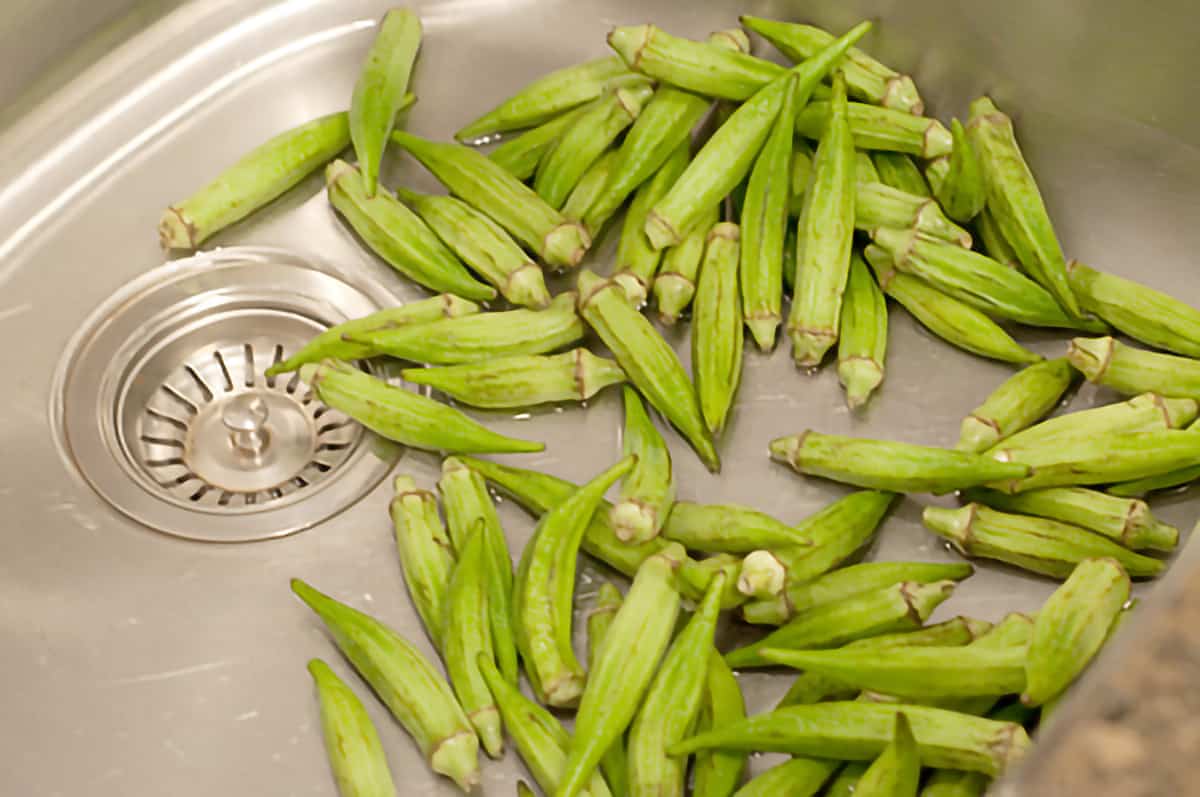
- Wash the okra in cold water. Trim the cut ends only if necessary. Do not cut into the body of the okra pod.
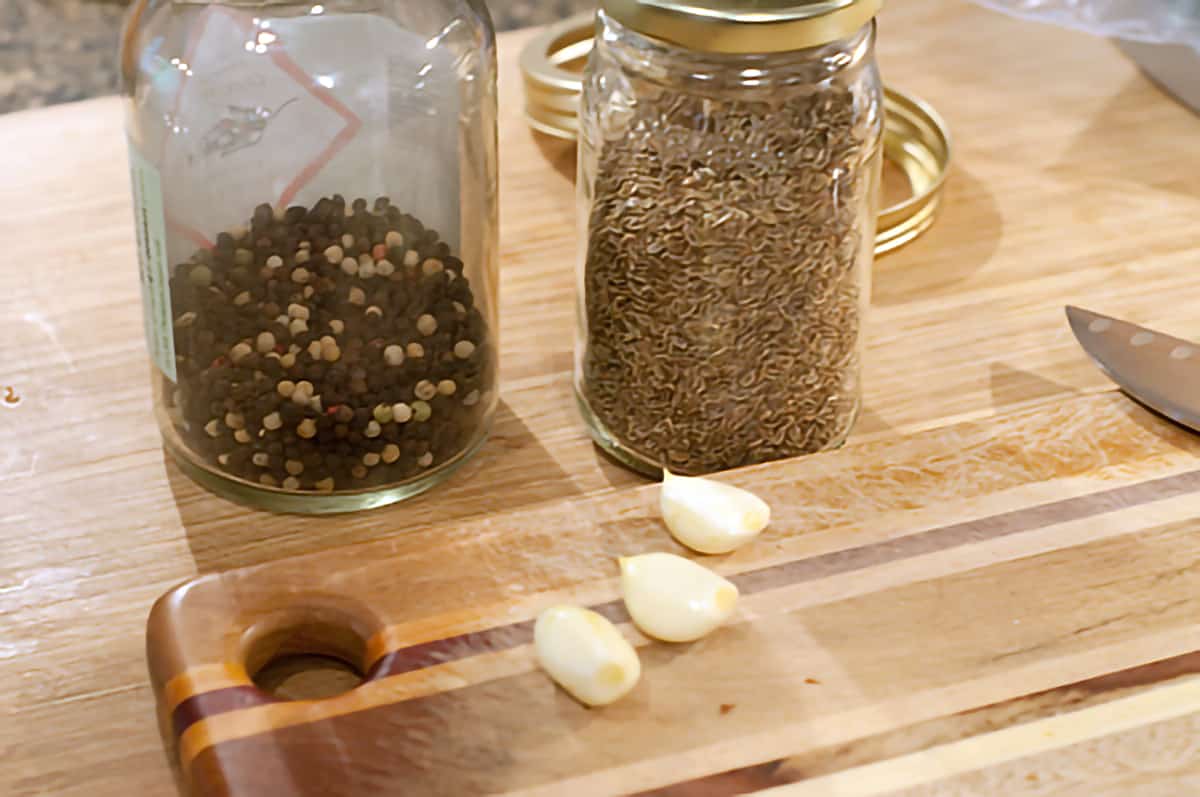
- Get the spices ready. You’ll need canning salt, dill seed, whole peppercorns, and garlic cloves. Peel the garlic, but leave it whole.
Umm…can you just pretend that there is some salt in that photo? It was sitting off to the side…oops.
Fill the Jars
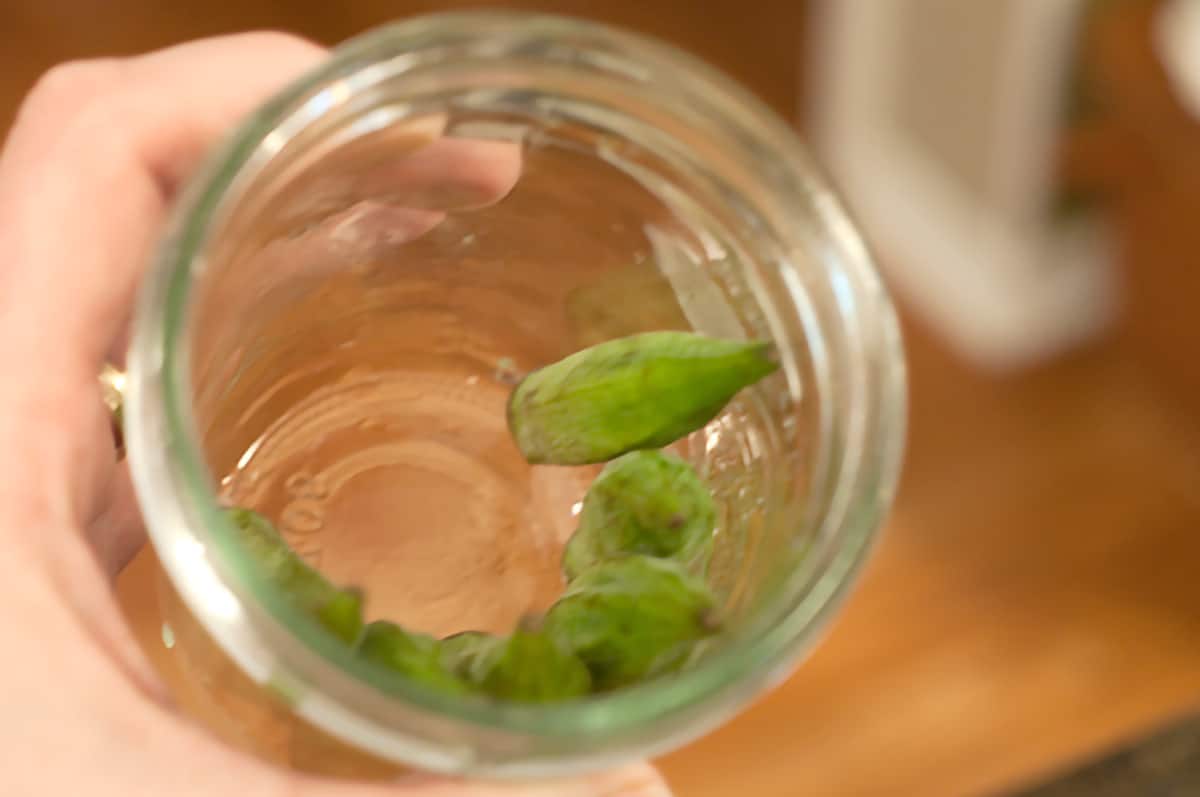
👉 PRO TIP: Sterilize three pint jars and rings according to standard canning procedures. Briefly, you’ll wash them in hot, soapy water and then submerge them in boiling water (the water in the canner works great!) for a few minutes while you prepare everything. To prepare the lids, wash and rinse them and hold them in barely simmering water until needed.
- Into the sterile jars, pack as many pods of okra as possible with the tips pointing up. Pack the okra tightly but be careful not to crush the pods.
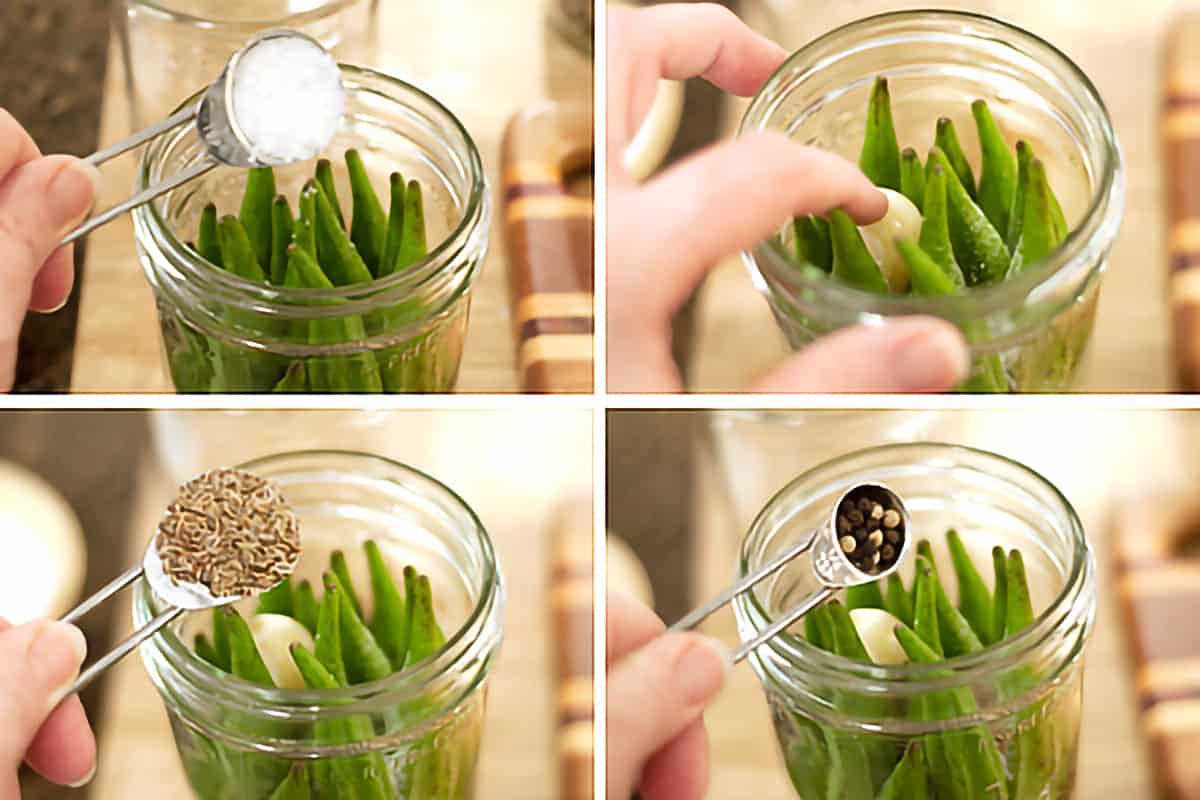
- To each jar add 1 teaspoon of canning salt, 1 whole garlic clove, 1 teaspoon of dried dill seed, and 1/4 teaspoon of whole peppercorns.
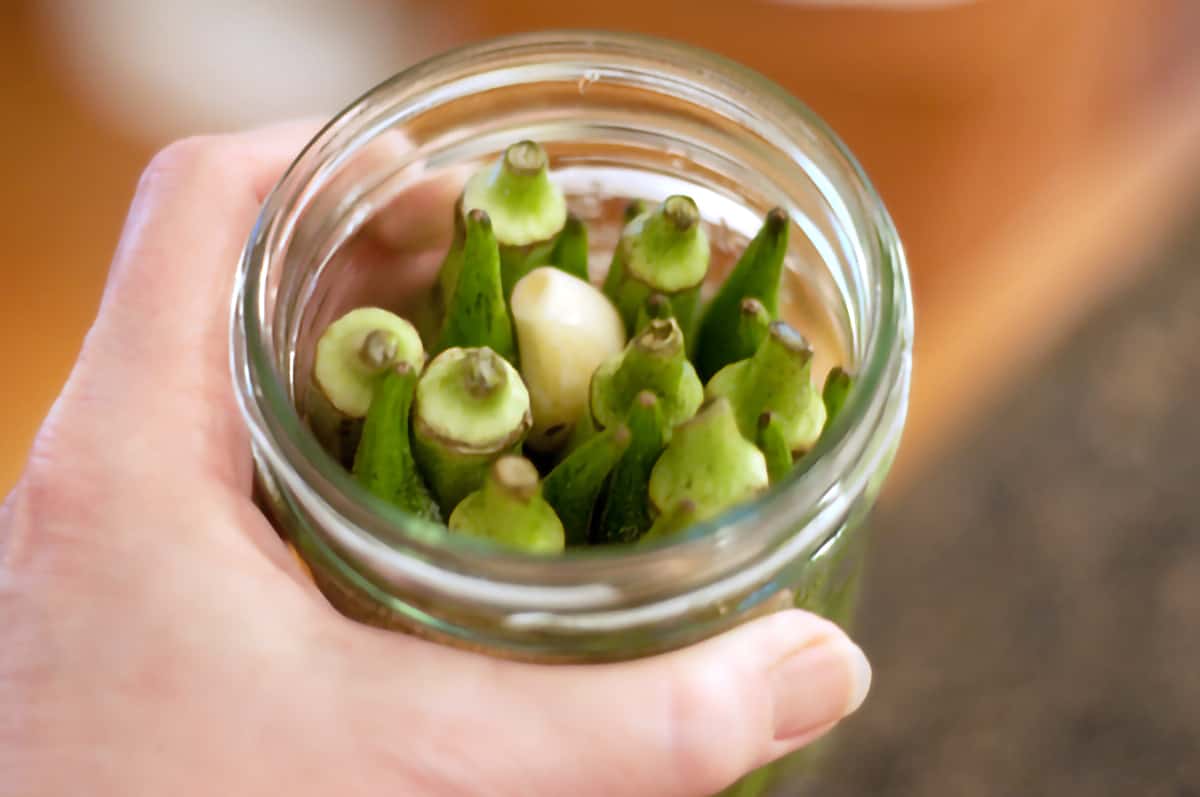
- Finish packing the jars as fully as possible with additional okra, tips down, fitting the pods in tightly but taking care not to crush the okra.
- Bring the vinegar and water to a boil.
- Using a funnel, fill jars with the vinegar and water mixture to within 1/4 inch of the rim.
Close the Jars and Process in a Water Bath
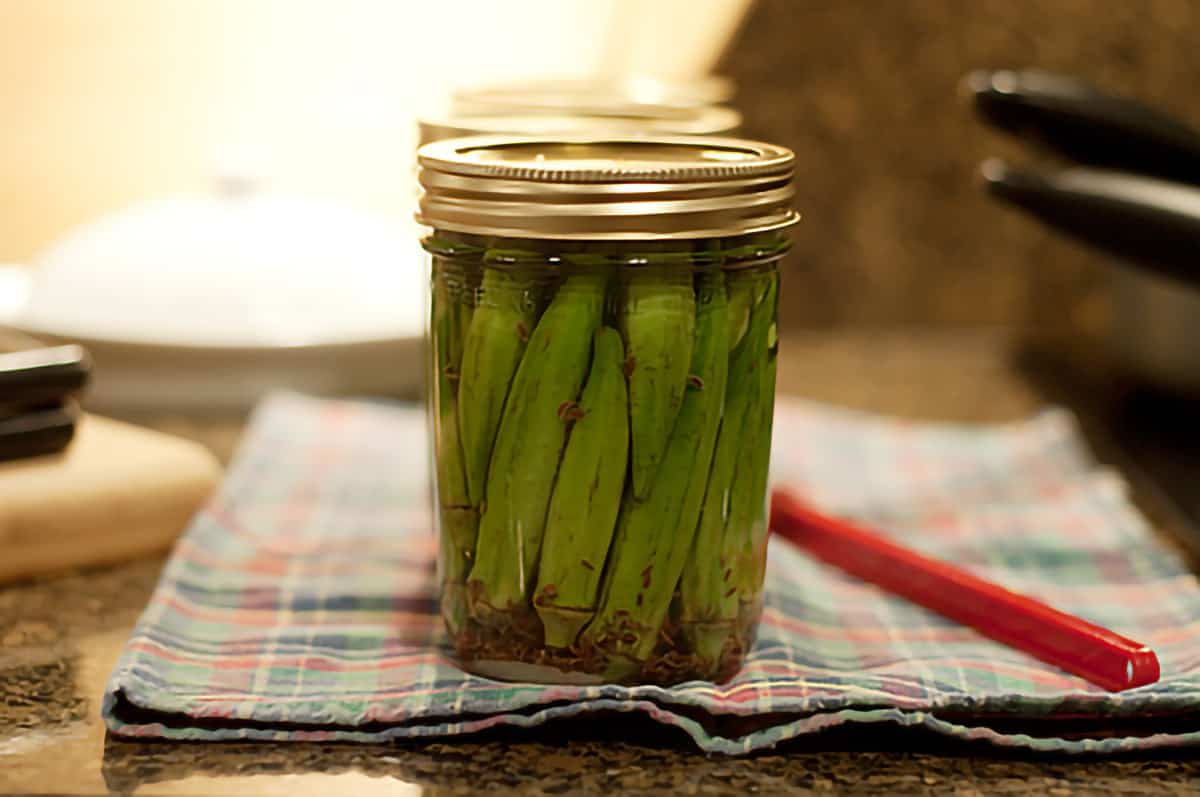
- Wipe the jar rims and place the lids and rings on the jars. Screw the lids on finger-tight.
- Process in a boiling water bath for 10 minutes.
Allow Cooling Time
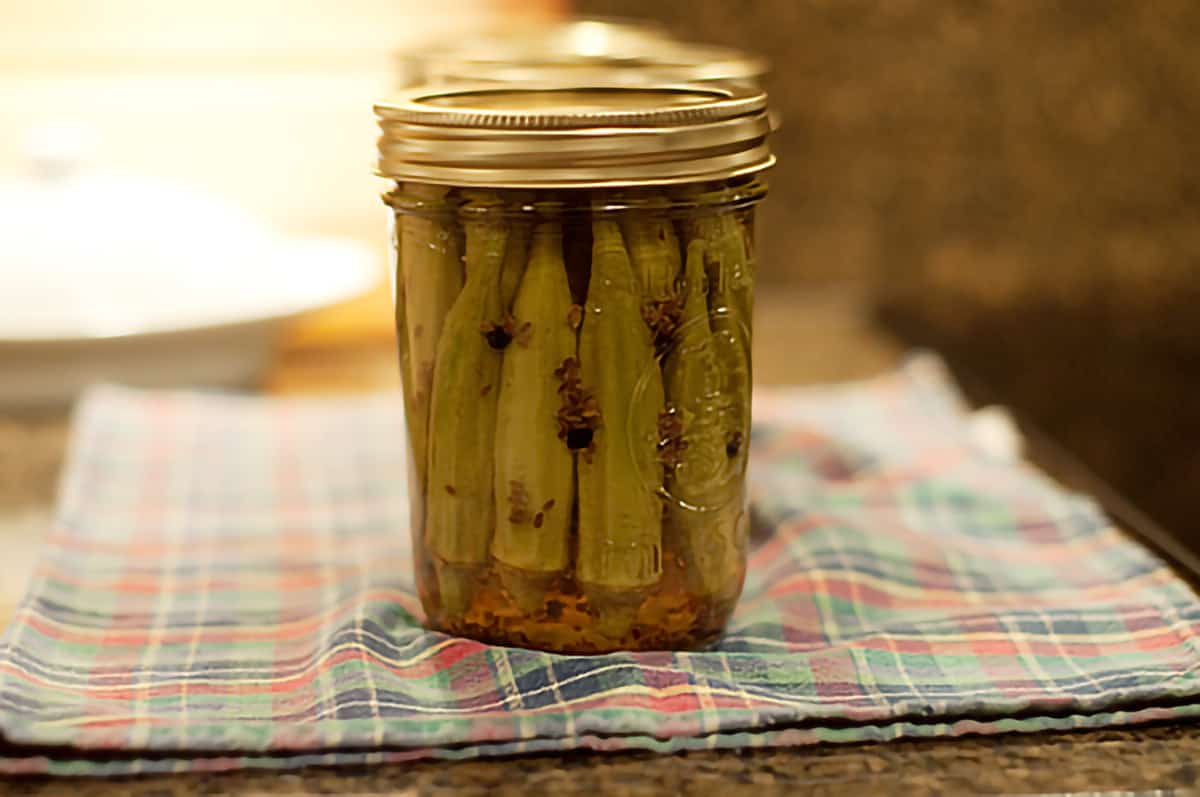
- Remove the jars from the canner and allow them to cool completely (12 to 24 hours).
- After the jars have cooled, test for a complete seal and then store in a cool, dark place. Any jars that didn’t seal completely may be stored in the refrigerator and used first.
👉 PRO TIP: Notice the difference in color after they come out of the canner. The okra has taken on a beautiful olive green color.
🤔 How long does it take for okra to pickle?
Let the pickles sit for about 4 to 6 weeks to achieve the best flavor.
✅ How long does pickled okra last?
Properly stored in a cool, dark place, pickled okra should last approximately one year.
❄ Can I use frozen okra for canning?
Sorry, but frozen okra isn’t good for canning. The freezing process breaks down microscopic cell walls in the okra making it too soft for pickles.
🍏 Can I use cider vinegar?
Pickling requires vinegar with at least 5% acidity for safety reasons. Cider vinegar is usually about 2-3% acidity.
🌶 Can I make it spicy?
Absolutely! To make hot pickled okra, simply add a dried red chile pepper to each jar before filling with the hot vinegar and water mixture.
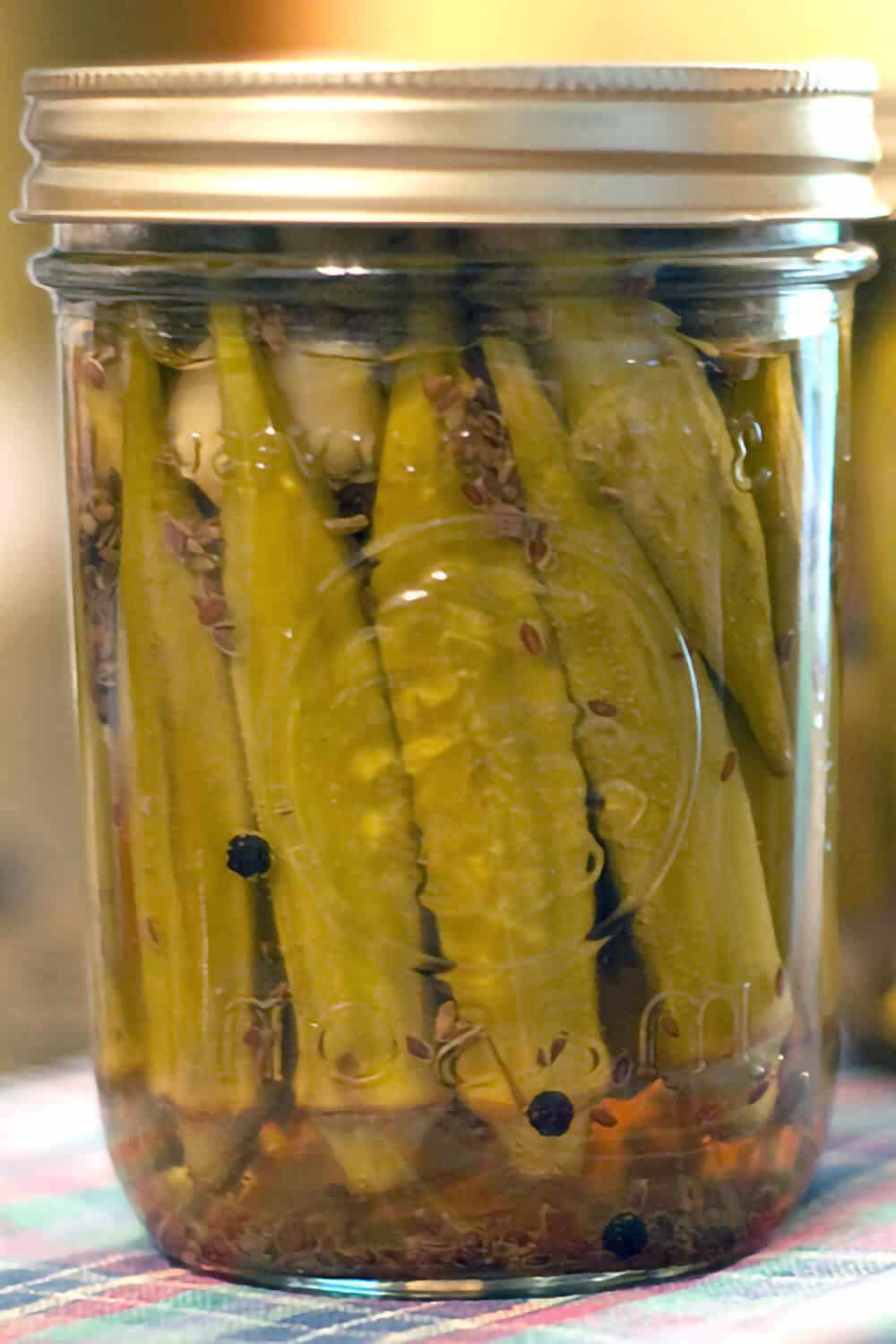
❓ Questions About Pickling Okra
Pickled okra is not slimy. Not even a little bit. Okra only gets slimy when it’s cut into and you don’t cut the okra to make pickles. Besides that, vinegar neutralizes the slime anyway so the pickles would never have a chance of becoming slimy.
You can use any vinegar that has at least 5% acidity for pickling.
Your okra is tough because it was too mature when you purchased or harvested it. When choosing okra for pickling or for cooking, bigger is not better. You want young, tender pods of about 3 to 4 inches in length.
Pickled okra is shelf stable as long as it’s correctly processed and the lids formed a good seal on the jars. If one or more jars did not seal in the canning process, those can be stored in the refrigerator and used first. Do store the unused pickles in the refrigerator after you open a jar.
Serve pickled okra anywhere you’d usually serve dill pickles. It’s delicious with sandwiches, alongside summer vegetables, or on a southern themed meat and cheese tray.

Questions? I’m happy to help!
If you have more questions about the recipe, or if you’ve made it and would like to leave a comment, scroll down to leave your thoughts, questions, and/or rating!
Thanks so much for stopping by!
📖 Recipe
Want to save this recipe?
Enter your email below and get it sent straight to your inbox.
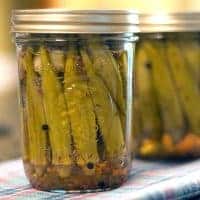
Pickled Okra
Ingredients
- 2 pounds okra choose small tender pods (may need more or less than two pounds)
- 3 cloves garlic peeled
- 3 teaspoons canning salt
- 3 teaspoons dill seed
- ¾ teaspoon whole peppercorns
- 1 ½ cups white vinegar 5% acidity
- 1 ½ cups water
Instructions
- Prepare jars, rings and lids according to standard canning procedure.
- Into the sterile jars, pack as many pods of okra as possible with the tips pointing up.
- To each jar add 1 whole garlic clove, 1 teaspoon of canning salt, 1 teaspoon of dill seed and 1/4 teaspoon of whole peppercorns.
- Finish packing the jars as much as possible with additional okra, tips down, fitting the pods in tightly but take care not to crush the okra.
- Bring the vinegar and water to a boil. Fill jars to within 1/4 inch of the rim.
- Place lids and rings on jars and process in a boiling water bath for 10 minutes.
- Remove jars from the canner and allow them to cool completely.
- Let the pickles sit for 4-6 weeks to achieve the best flavor.
Notes
- When preparing the okra, trim the tops only if needed. Be careful not to cut into the body of the okra pod.
- Sterilize the jars and rings according to standard canning procedures. Briefly, you’ll wash them in hot, soapy water and then submerge them in boiling water (the water in the canner works great!) for a few minutes while you prepare everything. To prepare the lids, wash and rinse them and hold them in barely simmering water until needed.
- Any jars that didn’t seal completely may be stored in the refrigerator and used first.
Nutrition Information
Nutrition information is calculated by software based on the ingredients in each recipe. It is an estimate only and is provided for informational purposes. You should consult your healthcare provider or a registered dietitian if precise nutrition calculations are needed for health reasons.
— This post was originally published on September 10, 2010. It has been updated with additional information.

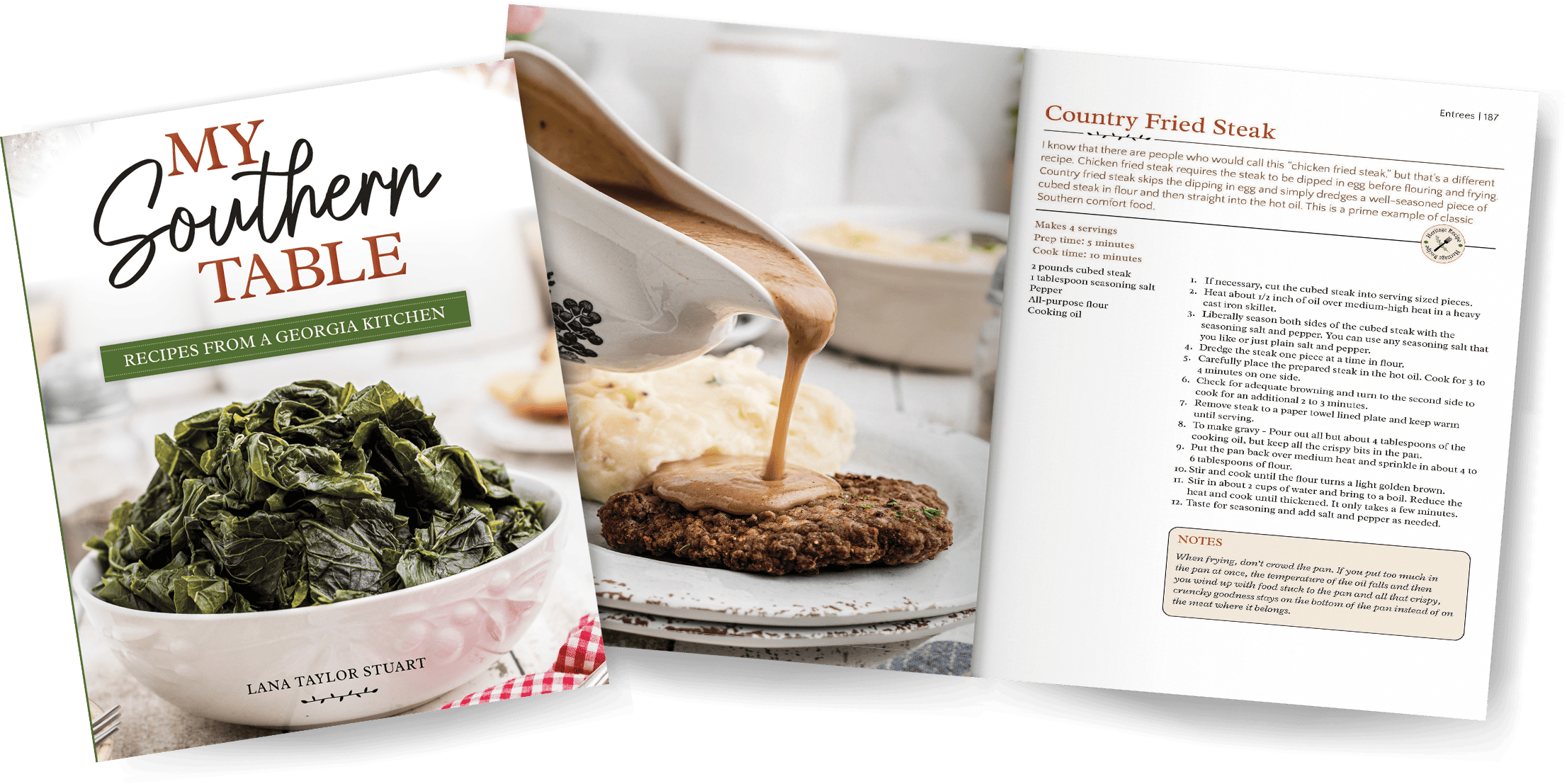
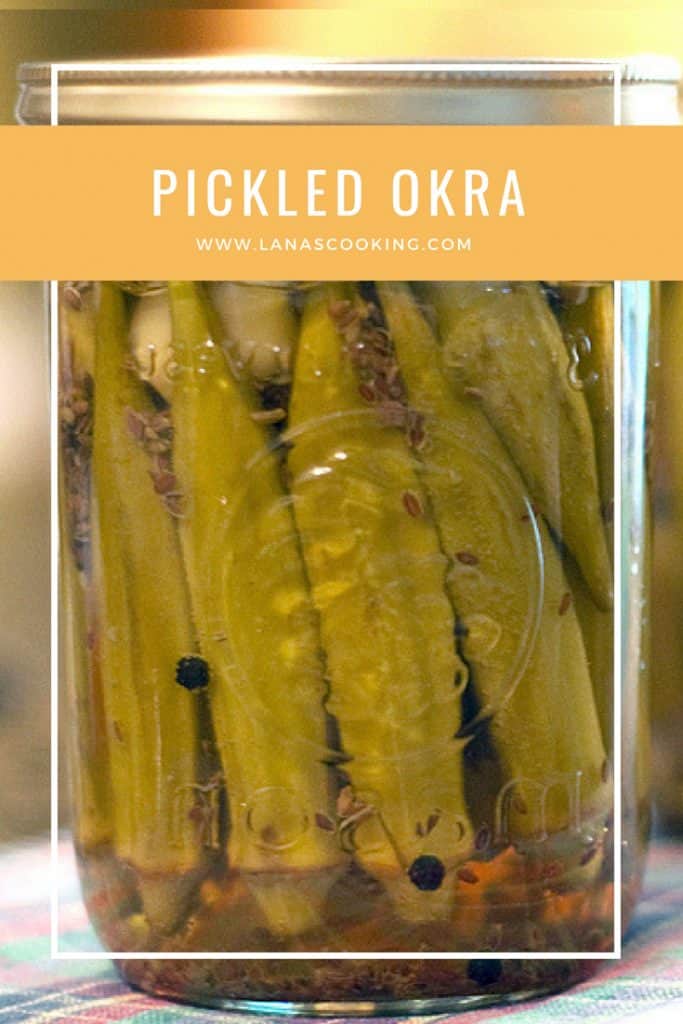
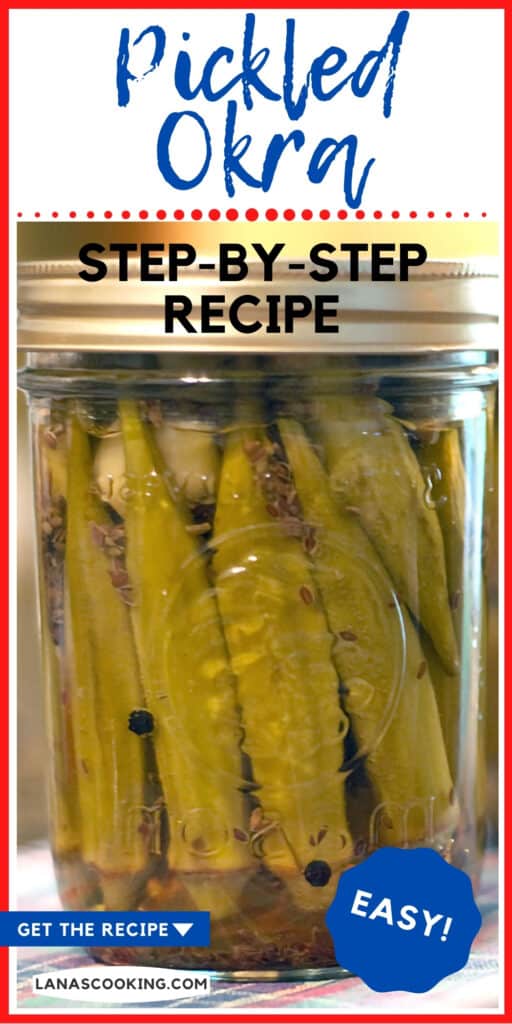
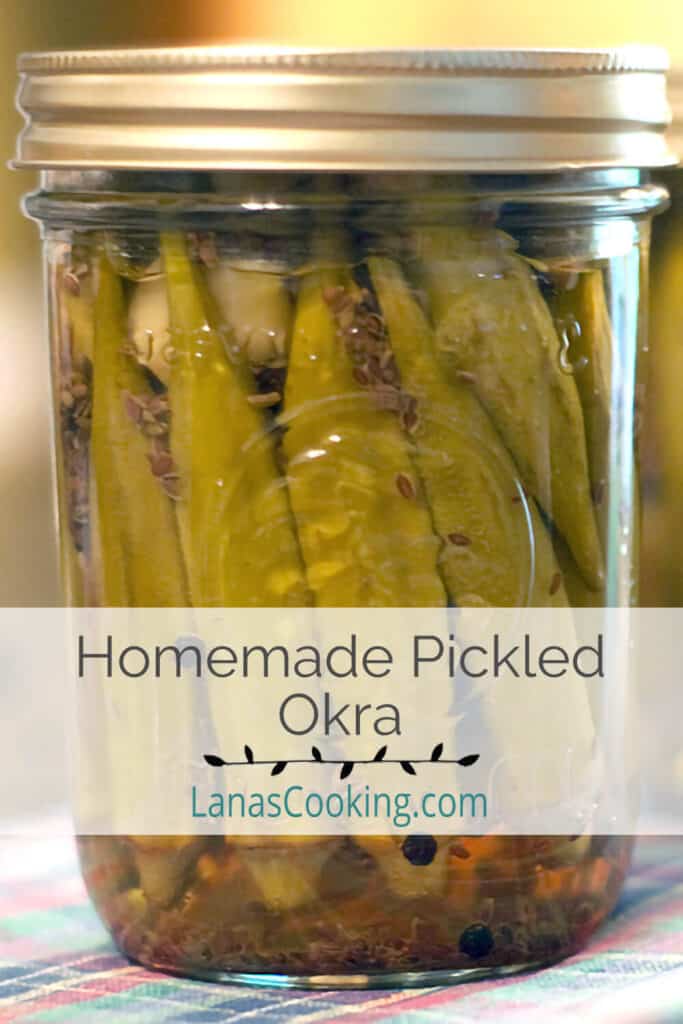
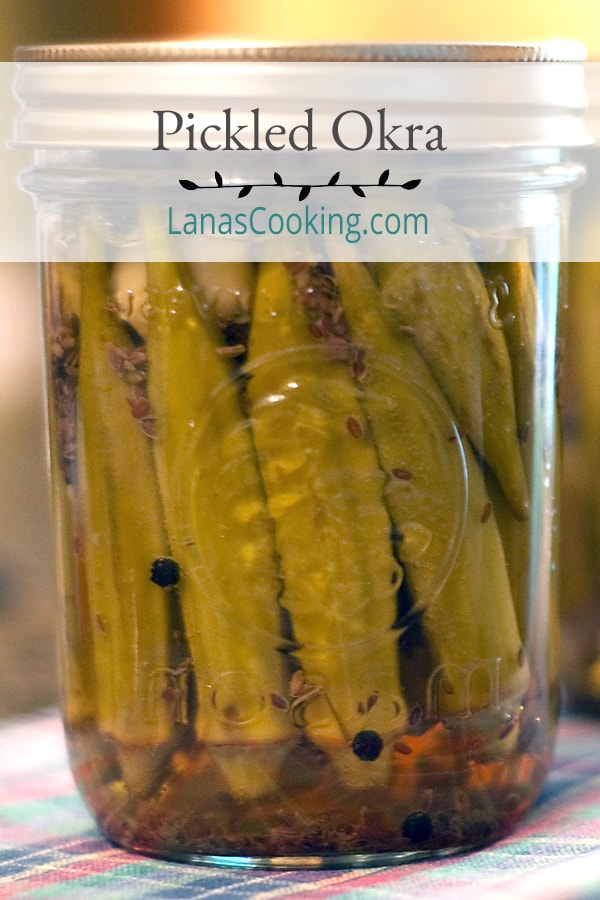


I made this recipe but added a clicked jalapeño to each jar to make spicy okra and it turned out perfect!
I’m not sure what a “clicked jalapeno” is, but I’m glad it turned out good for you!
Sorry I meant sliced jalapeño and my phone autocorrected
Hey, I’m [email protected]. My okra seemed to seal but the juice in the jar seems lower then I filled my jars making me think they might not have sealed correctly. I stabbed each okra with a fork so the brine could go inside the okra. Someone said to do that. My jars look good and sound and seem sealed. Could my juice have gone inside my okra or did it not seal properly? I’m worried. I was tight on head space and now low on juice but my water bath seems to have worked perfectly? Is that low juice volume normal??? It’s not like tons just down a little.
So, in the text of the post and also in the notes on the recipe card I do say specifically NOT to cut into the body of the okra pod. By piercing the okra with a fork, you created a way for the brine to enter the okra pod. It sounds like that’s what happened during the canning process causing the level of brine in your jars to go down. As long as the jars are sealed and were processed for the correct time, it should be safe to eat. The tops of the okra that are above the level of the brine may need to be trimmed off before serving. You’ll also probably get a LOT of brine spurting out when you bite or cut into one of the pickles.
can I just use the pickling recipe and opt out of the canning part?
If you don’t process the jars, you’ll have to store the finished pickled okra in the refrigerator and use within three months. They won’t be safe for room temperature storage without processing in a water bath.
I made a few batches of this recipe this summer and am excited to try it. The first ones will be ready in a couple weeks. I noticed with my last batch that the brine seemed to Thicken. it is still clear, just seems thicker in the jar. Have you ever encountered this?
I haven’t ever seen that. My guess is that it’s some of the viscous liquid from the okra mixed with the pickling liquid. If you processed and stored the jars correctly, it should be okay.
Would Pickle Crisp be recommended for this? I don’t want them to be mushy. If so, how much per jar?
I do not use any kind of crisping agent in any of my recipes.
How could I make these sweet?
Thank you
Sorry, I don’t have an approved canning recipe for sweet pickled okra.
I really want to try this recipe but do not have a canner. Is this possible to do if I do the recipe but place the jar directly into the refrigerator?
If you have a deep stockpot or something similar you can use that. If you want to try converting the recipe to a “refrigerator pickle” recipe, you’ll need to store your finished jars of pickles in the refrigerator only. They won’t last as long as canned pickles so you’ll need to use them within a month.
I use a similar recipe for my base when pickling okra. I wanted to comment on using cider vinegar. I’ve got 2 different brands of cider vinegar and both are labeled diluted down to 5%. I also have white vinegar labeled at 6% and I have always used cider vinegar when canning. I haven’t had any issue using either. Thanks for your recipe and helpful info!!
Any vinegar with at least 5% acidity is safe for canning. There is, however, a difference in taste.
Absolutely delicious!
I feel silly for asking, but I can’t seem to find the vinegar-water ratio in the recipe.
The recipe states 1 1/2 cups white vinegar, 1 1/2 cups water. If you want it stated as a ratio, it would be 1:1.
I’m making this now but do not have dill seed. Is it ok to use dill weed? Thanks!
I’m so excited for 4-6 weeks to come!
Dill seed and dill weed have a different taste. Dill weed has a more fresh taste and dill seed has a slightly bitter flavor. Most people recommend using caraway seed as a substitute for dill seed.
If you can possibly get dill seed, I strongly advise using it in the recipe.
Tried this. Very similar to my own recipe. I like mine a lot,as do many of my friends, but we like this as well. I add a half teaspoon of tumeric to each pint as well.
First time picking okra, this recipe was super simple
Thanks! I hope you enjoy the pickles!
What size jars?
The recipe makes 3 one-pint jars.
I love pickled okra. I can’t wait to try your recipe
I love it, too, Berlena! And I hope you like the recipe.
I just opened my first jar I made four weeks ago and it’s delicious!! Making two more batches today. My family loved it. Thanks for this great recipe!
Happy to know it turned out great for you!
First, I’m a rookie at pickled okra. I’ve loved it all my life but never made it. It’s possible I missed it, but I did not see instructions for making the brine in your recipe. I looked in vain for that in your recipe, and perhaps I missed it. I know that probably sounds dumb, but I wanted to get it right my first time, and I had to go find it in another recipe.
The recipe says “bring the vinegar and water to a boil.” That’s the “brine” or pickling liquid.
I’ve looked through older comments so please forgive me if I missed this…did you say how long this will be shelf stable? Thanks!
Thanks for asking, Tat. USDA guidelines say that any home canned food should be consumed within one year.
Can you use a pressure canner for processing?
Not for this recipe. This is a boiling water bath process.
I made this pickled okra last year and my 90 year old sister loved it. Needless to say I will be canning more this year. Great recipe and easy.
I’m so glad your sister like the pickles!!
If I’m making quarts I just double the amount of canning salt, etc. that goes into each individual jar right?
Someone else asked about making quarts. As I explained to them, I don’t have proven processing times for quarts and neither does the National Center for Home Food Preservation so I can’t give any advice on making pickled okra in quarts.
Have used Lana’s okra canning recipe the last 2 years and it always has been a family favorite!B
That’s so nice to hear! I’m glad you like it.
Lana,
I’m getting ready to use this recipe and I would like to decrease the salt. Is this possible? Also, do the peppercorns add any heat? I can’t tolerate much heat/spiciness.
You can decrease the salt if you like. It’s for flavor, not for preservation. The peppercorns do not add heat, only flavor.
I love this recipe this is the same recipe I use for my picked okra
Lana, how long do you process quarts for this recipe? We love the pickled okra and want it in quarts. Thank you!
I don’t have a processing time for quarts. I checked the National Center for Food Preservation at the University of Georgia and they only give processing time for pints as well. However — I have seen some other online recipes that say to add 5 minutes for quarts but I can’t say for sure how accurate that is.
Easy to do Recipe but have not tried the finished product.
I do hope you enjoy it!
It took twice as much vinegar water liquid to fill the jard
If you find that you need more brine to fill the jars, that indicates that there is not enough okra packed into the jars.
I also agree in doubling the brine batch. I doubled and it filled 4 jars. Not all okra is the same and sometimes it’s hard to fit a lot in a jar due to the differences in varieties and sizes. Great recipe though.
Could you please tell me how many pints this recipe makes? I would greatly appreciate it!
Sure! This recipe makes three pint jars. You can easily double or triple it you’d like to make more.
Can I pickle green beans with the same recipe?
I’ve never pickled green beans with this recipe. There’s a great recipe for them on the NCHFP site at this link – https://nchfp.uga.edu/how/can_06/dilled_beans.html I would use that one :-)
You said “Pickled okra is not slimy. Not even a little bit. Okra only gets slimy when it’s cut into and you don’t cut the okra to make pickles. Besides that, vinegar neutralizes the slime anyway so the pickles would never have a chance of becoming slimy.”
But my pickled Okra does get slimy. I use a 50/50 mix of vinegar to water as you do. Could I be packing the pods too tightly causing them to get slimy? If I have a few too long and trim the blossom end, would that cause the batch to be slimy? I pickled okra years ago and it turned out fine, this year, not so much
Interesting that I’ve never had that happen and I’ve been using this recipe for pickled okra for about 40 years. I’ve also purchased pickled okra many times and never found any that was the least bit slimy.
I did some research and here’s what the National Center for Home Food Preservation says — “slippery/slime in pickled foods can be caused by: leaving on the blossom ends, not enough vinegar, using weaker than normal vinegar (less than 5%), not enough brine, improper processing, or molds on any of the ingredients.”
With okra pickles, you want to be careful not to cut into the okra pod below the “neck” area although even then the vinegar should neutralize any mucilage released.
can you add alum for a crispy spear when you can it ? I have used it in canning pickled green beans and they do turn out crispy.
Hi Jacie – I don’t use alum in my pickle recipes and haven’t tested this one with it. You can certainly try it if you like. Found this info from USDA, in case you’re interested: “Alum may still safely be used to firm fermented cucumbers, but it does not improve the firmness of quick-process pickles. If you use good-quality ingredients and follow current canning methods, alum is not needed. If you do use alum, do not use more than 1/4 teaspoon per quart of pickling liquid.”
Great recipe made several pints added some Carolina Reapers to a few
You’re braver than me! Way too hot for me, but I hope you enjoy them!
I just canned 7 pints of pickled okra and several jars have pods that split open, exposing seeds the length of the pods. Total loss??
No, not at all. As long as the jars sealed and they were processed correctly, the pickles should still be safe, they just won’t be as pretty. However, I can’t imagine how that happened. I’ve never seen it, ever.
So simple and delicious. I added a couple slices of pickles jalapeños to each jar and they are perfect!
Great stuff right there. I put a few red pepper flakes in mine.. gives a little zest to it
Thanks, Glenn. I sometimes add a dried red pepper to the jar.
We grow okra every other year and this recipe has been very successful this, our growing year. Like the small batches.
Can i put in a jalapeno pepper?
Sure. Most recipes for hot canned okra specify a dried red pepper, but I see no reason why a jalapeno wouldn’t work. It would still be safe for canning.
Could you use dill weed all the stores around me can’t get dill seedB
You can try to substitute, sure. I think it would be equal amounts, but do your own research on that. Just FYI – dill seed is available from Amazon.
Hi,is it normal for some of the liquid to disappear in the jars after they have set for several days,? thanks
Not after sitting for days, no. Sometimes you’ll lose liquid into the canner if the lids or rings aren’t applied correctly. But you shouldn’t lose liquid after the jars sit for several days.
Hey, My liquid is also low after canning. Should I have split the Okra before putting the brine in so that it could enter the pods?
Hi Donna – no, don’t split or pierce the okra pods. That would cause even lower liquid because it would be absorbed into the okra. Unless I was there with you watching your process, there’s really no way for me to know what happened, but you should not experience a significant liquid loss during the canning process. Here’s an article that goes into all the things that can cause liquid loss during canning — https://www.pickyourown.org/canning-problems-loss-of-liquid.php And one more for reference: https://nchfp.uga.edu/how/general/cannedfoodproblems.html
Thank you for your reply and links. It looks like I packed the okra to tightly. I have done another batch and they are fine. !!
I am a GA native, and this recipe looks great, but I have one question, based on my lifelong search for the perfect homemade pickled okra: is the pickled okra crispy when it finally emerges from the jar? Thank you!
It’s fairly crisp. Like any homemade pickle, it gets cooked a bit during the canning process (there’s no help for that) so it won’t be like raw-crisp. I think it’s delicious anyway.
Can you use Apple Cider Vinegar for pickle okra?
Yes, you can as long as it’s 5% acidity. It will make the pickles darker, though.
Just fixed 5 pints of your Pickled Okra going to be a long hard wait until July 1.
Ha ha! Put them somewhere out of sight so you won’t think about them. But, yeah, they are so much better after they sit for a few weeks.
Is it possible to make this recipe using square mason jars with clamp top lids? Or do i need to use standard screw top jars?
The clamp top jars are usually meant for display or dry storage rather than for the actual canning process. You could contact the manufacturer of your jars to find out whether they are suitable for water bath canning.
I love pickled okra, always have. Just never new how to do it. Thanks to you, I don’t have to pay those high high prices in the stores any more. I can just head to the basement and pull out a jar. I’m considering making some to give away as Christmas gifts. Do you think the packaged okra that you find in the grocery stores would work well?
THANKS!
Yes, you could use fresh okra from the grocery store. Just make sure it’s young and tender, not woody.
My family loves pickled okra. I cannot make enough. I have pickled at least 80 pints so far. I children, 8 to 15, eat a pint jart each night and they fight over who gets the garlic clove. I really think that is why they are never sick.
Just made 6 pints…I cant wait!!!!
I also love pickled okra but as a transplanted Southerner now living in the Canadian Rockies, this is not an item I can easily find on the grocery shelf! My father and grandfather are from Morgan County, Georgia and I remember as a child my grandmother making pickled okra. Finally saw some baby okra at my nearby Asian store while shopping for catfish today and my taste buds started thinking of the treat from my childhood. Baby okra is now chilling in my fridge awaiting transformation tomorrow morning. My catfish was grilled on the BBQ tonight, but served in true Southern fashion with cheese grits and Southern Ice Tea to a few neighbours and my family. Neighbours thought Southern cooking was quirky but they all wanted the recipes for everything! My children, though first generation Canadians, have grown up with a mixture of Southern and Canadian cooking and I am proud to say they are better Southern cooks than I am! Thank you for this easy to do recipe.
Your Georgia BLT is next on my list
You’re welcome, Sam! I hope you enjoy your okra pickles and the Georgia BLT as well!
Yes, I love, love, love pickled okra. But then I like it raw, boiled, steamed, fried, pickled or just about any other way……. I was looking for a good old fashioned teacake like my grandmother made, and so hope I’ve found it. I can still smell them cooking. Just like you said, it takes you to another place. My mother and her family are from Waycross, GA so I hope the recipe will be similar……I’ll let you know. Thanks for both recipes and I have book marked your blog. I’ll be back as they say! Thanks for sharing…….I deal with food allergies, so always cook my own goodies!!!!
gloria g. – now in Hemingway, SC southern to the bone!
Just wondered if it’s okay to use fresh dill instead of dill seed?
Sure! The normal substitution is three heads of fresh dill for each tablespoon of dill seed.
I always grow okra in my garden, and I usually just fry it or cook it with tomatoes. I love pickled okra, but have never made any. This recipe is so easy and delicious! Thank you!
Oh and also Pickled okra that is new for me I gotta try it.
I had been in search of pickling recipe since I saw the last night tv show Unwrapped. Your looks the best and easiest. Thanks Lana. By the way do you have any recipes for canning fruits like peaches. Thank you in advance.
I do have recipes for canning fruits, but they’re not on the blog. Maybe next summer I’ll do a series of posts on those!
I just stopped by for the first time and had to say, your blog is beautiful! As for the orka, well it’s a bit outside of my comfort zone, but I’ll definitely be checking in again soon for other treats that might catch my eye :)
Please do stop by again, Kristin! There are 174 other posts besides the okra, so I’m sure there would be something in there you might like :-)
I’ve had these before and loved them, but have never made any myself, looks so easy!
It is easy, Angie. I hope you’ll give it a try!
Can you believe I have never had okra? That’s right, I haven’t! but these look pretty tasty I must admit!
Oh, yum! I’d love to get a jar of these babies and would be happy to trade my favorite, flash-sauteed (non-slimy) Indian-spiced okra recipe. Deal? Bookmarked for later in the fall when my garden okra starts producing.
Deal!
That sounds good, share please your recipe, I love okra
Lana, great pickle recipe. I am a big fan of okras whether they are grilled, pickled, fried, or any other method of cooking them.
pickled okra is such a great treat and can be used in so many things – I did not know folks were so into these – it has been one of the top recipe searches on my site all summer… hope you get a lot of traffic from this one too
I will admit that I have never tried pickled okra, but from your description (and the fact that they are pickled – can’t resist), I’m sure I would love these.
I’ve never ever cooked with okra or done anything with it, really. I do love dill pickles, though, so maybe I’d love these even more!
They are really very good. Great with a Bloody Mary!
Oh, yum. I love pickled okra. I always get a store bought jar to keep in the refrigerator. Your family are so lucky. Tien :)
Thank you, Tien. Maybe you’ll try making some homemade pickled okra now?
I love pickled okra. When I lived in the south I had it in my fridge at all times. When I moved back to New England no one heard or had had it. I couldn’t find it till one day I was at a store that every once in awhile had an off item. Lo and behold there was a few jars. I was doin the happy dance. Since then been without looking to purchase online. I housebound so getting ingredients and making is near imposible for me. When/if I can I will make.
Thanks for shareing recipe, I hope to be able to make it and share and enjoy.
Sherry